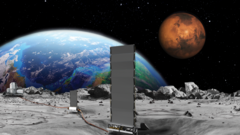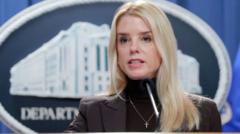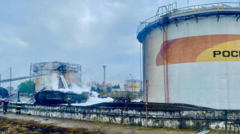This ambitious project comes amidst tantalizing discussions regarding international space exploration competitiveness and technological advancements.
NASA's Ambitious Plan: Nuclear Reactor on the Moon by 2030

NASA's Ambitious Plan: Nuclear Reactor on the Moon by 2030
U.S. space agency NASA aims to establish a nuclear reactor on the Moon within the next decade as part of its strategy for a permanent lunar settlement.
NASA's Fission Surface Power Project seeks to fundamentally redefine lunar energy capabilities, facing both financial and logistical hurdles to achieve a permanent human presence on the Moon.
NASA is accelerating its plans to deploy a nuclear reactor on the Moon by 2030, as reported by U.S. media. This initiative is part of the broader U.S. goal to establish a permanent human base on the lunar surface. Citing similar ambitions from China and Russia, NASA’s temporary head has indicated that these nations could potentially create geopolitical boundaries, referred to as "keep-out zones," on the Moon.
There remain significant doubts regarding the feasibility of achieving this timeline, particularly in light of recent budget reductions experienced by NASA, which have raised concerns among scientists about the underlying motivations of this endeavor. Currently, multiple nations—namely the U.S., China, Russia, India, and Japan—are competing to explore the Moon, with some eyeing the construction of permanent outposts.
U.S. Transport Secretary Sean Duffy, who is acting administrator of NASA, emphasized the urgent need for high-power energy to support a lunar economy and strengthen national security in space. He has invited proposals from private sector companies to design a reactor capable of generating at least 100 kilowatts of power, which is comparatively minor when evaluated against typical wind turbines generating 2-3 megawatts.
The proposal of a nuclear reactor on the Moon is not revolutionary; NASA had previously provided three contracts worth $5 million to companies for reactor design prototypes. Moreover, both China and Russia have announced intentions to build an automated nuclear facility on the Moon by 2035. Given the Moon's cyclical 14-day sunlight and darkness cycle, solar energy provision is complicated, making nuclear energy a more compelling option.
Experts like Dr. Sungwoo Lim from the University of Surrey assert that generating megawatt-scale power is crucial for supporting lunar habitats. Lionel Wilson, a professor at Lancaster University, mentioned that it is technically viable to install reactors by 2030 with sufficient funding. He pointed out that existing designs for small reactors can facilitate this project, contingent on successful Artemis launches.
There are apprehensions over the inherent risks tied to launching radioactive materials through Earth's atmosphere, although experts believe overcoming these challenges is possible. Duffy's unexpected directives follow substantial budget cuts of 24% for NASA slated for 2026, which include significant pullbacks on various scientific programs, such as the Mars Sample Return initiative aimed at sample retrieval from the planet.
Some scientists express concern that recent announcements reflect a politically driven race rather than a science-focused exploration mission. They worry that prioritizing national interests could detract from the broader goal of exploring the solar system.
Duffy’s remarks highlight the potential ramifications of China and Russia establishing a "keep-out zone" on lunar territory, referencing the Artemis accords—a collaborative agreement on international standards for Moon exploration signed by seven nations in 2020.
However, Dr. Barber emphasizes that practical challenges, including the infrastructure for transporting personnel and equipment to the Moon, must be addressed before the nuclear reactor can be beneficial. Furthermore, uncertainty stemming from funding and project timeline disruptions raises doubts about the viability of this ambitious plan.
NASA is accelerating its plans to deploy a nuclear reactor on the Moon by 2030, as reported by U.S. media. This initiative is part of the broader U.S. goal to establish a permanent human base on the lunar surface. Citing similar ambitions from China and Russia, NASA’s temporary head has indicated that these nations could potentially create geopolitical boundaries, referred to as "keep-out zones," on the Moon.
There remain significant doubts regarding the feasibility of achieving this timeline, particularly in light of recent budget reductions experienced by NASA, which have raised concerns among scientists about the underlying motivations of this endeavor. Currently, multiple nations—namely the U.S., China, Russia, India, and Japan—are competing to explore the Moon, with some eyeing the construction of permanent outposts.
U.S. Transport Secretary Sean Duffy, who is acting administrator of NASA, emphasized the urgent need for high-power energy to support a lunar economy and strengthen national security in space. He has invited proposals from private sector companies to design a reactor capable of generating at least 100 kilowatts of power, which is comparatively minor when evaluated against typical wind turbines generating 2-3 megawatts.
The proposal of a nuclear reactor on the Moon is not revolutionary; NASA had previously provided three contracts worth $5 million to companies for reactor design prototypes. Moreover, both China and Russia have announced intentions to build an automated nuclear facility on the Moon by 2035. Given the Moon's cyclical 14-day sunlight and darkness cycle, solar energy provision is complicated, making nuclear energy a more compelling option.
Experts like Dr. Sungwoo Lim from the University of Surrey assert that generating megawatt-scale power is crucial for supporting lunar habitats. Lionel Wilson, a professor at Lancaster University, mentioned that it is technically viable to install reactors by 2030 with sufficient funding. He pointed out that existing designs for small reactors can facilitate this project, contingent on successful Artemis launches.
There are apprehensions over the inherent risks tied to launching radioactive materials through Earth's atmosphere, although experts believe overcoming these challenges is possible. Duffy's unexpected directives follow substantial budget cuts of 24% for NASA slated for 2026, which include significant pullbacks on various scientific programs, such as the Mars Sample Return initiative aimed at sample retrieval from the planet.
Some scientists express concern that recent announcements reflect a politically driven race rather than a science-focused exploration mission. They worry that prioritizing national interests could detract from the broader goal of exploring the solar system.
Duffy’s remarks highlight the potential ramifications of China and Russia establishing a "keep-out zone" on lunar territory, referencing the Artemis accords—a collaborative agreement on international standards for Moon exploration signed by seven nations in 2020.
However, Dr. Barber emphasizes that practical challenges, including the infrastructure for transporting personnel and equipment to the Moon, must be addressed before the nuclear reactor can be beneficial. Furthermore, uncertainty stemming from funding and project timeline disruptions raises doubts about the viability of this ambitious plan.



















